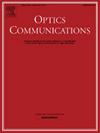Quantum photonic communications with four-dimensional constellations of coherent states undergoing phase noise
IF 2.2
3区 物理与天体物理
Q2 OPTICS
引用次数: 0
Abstract
We present the analysis of the quantum detection of modulated coherent states used in quantum communications systems that employ the degrees of freedom of both the complex amplitude and the state of polarization of the optical carrier, in the presence of optical phase fluctuations, unavoidable in realistic laser fields as optical sources in photonic communications.
We analyze several photonic M-ary constellations with different four-dimensional (4D) formats with joint modulation of the field quadratures and the states of polarization of quantum coherent states affected by optical phase noise, of interest in quantum photonic communications, cryptography, and other applications.
For the quantum state detection/discrimination at the receiver, we employ the square root method (SRM) for the received phase-diffused 4D constellations, constituted by a set of mixed quantum coherent states, and arrive at results on their performance in error probability, as well as their mutual information, spectral and photon number efficiencies.
We find that the overall performances of our 4D Polarization-Shifted and Polarization-Multiplexed constellations are better than those of their single polarization counterparts; also, our binary and quaternary Phase-Shift-Keying formats perform better than the On-Off-Keying and Pulse-Position-Modulation schemes, with a trade-off with their sensitivity to phase noise, which is quantified in our analysis.
具有相位噪声的四维相干态星座的量子光子通信
我们对量子通信系统中使用的调制相干态的量子探测进行了分析,该系统使用了光载体的复振幅和偏振态的自由度,在存在光相位波动的情况下,作为光子通信光源的现实激光场不可避免地会出现光相位波动。我们分析了几种具有不同四维(4D)格式的光子 M-ary 星群,这些星群对受光学相位噪声影响的场正弦和量子相干态的偏振态进行了联合调制,这在量子光子通信、密码学和其他应用中具有重要意义。为了在接收器上进行量子态检测/判别,我们对接收到的相位差 4D 星群(由一组混合量子相干态构成)采用了平方根法(SRM),并得出了它们在错误概率、互信息、光谱和光子数效率方面的性能结果。我们发现,4D 偏振移频和偏振多路复用星座的整体性能优于单偏振星座;此外,我们的二进制和四进制移相键控格式的性能也优于开-关键控和脉冲位置调制方案,但它们对相位噪声的敏感性需要权衡,我们在分析中对此进行了量化。
本文章由计算机程序翻译,如有差异,请以英文原文为准。
求助全文
约1分钟内获得全文
求助全文
来源期刊

Optics Communications
物理-光学
CiteScore
5.10
自引率
8.30%
发文量
681
审稿时长
38 days
期刊介绍:
Optics Communications invites original and timely contributions containing new results in various fields of optics and photonics. The journal considers theoretical and experimental research in areas ranging from the fundamental properties of light to technological applications. Topics covered include classical and quantum optics, optical physics and light-matter interactions, lasers, imaging, guided-wave optics and optical information processing. Manuscripts should offer clear evidence of novelty and significance. Papers concentrating on mathematical and computational issues, with limited connection to optics, are not suitable for publication in the Journal. Similarly, small technical advances, or papers concerned only with engineering applications or issues of materials science fall outside the journal scope.
 求助内容:
求助内容: 应助结果提醒方式:
应助结果提醒方式:


